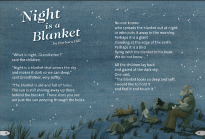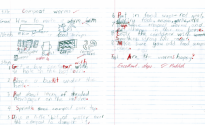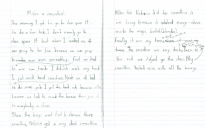You are here:
After three years at school

Reading
Reading
In their third year at school, students are beginning to use texts to meet the demands of learning across the curriculum as well as for instructional reading purposes.
After three years at school, students are reading, responding to, and thinking critically about a variety of texts at Gold level. They are preparing for the transition to the School Journal as their main source of instructional reading material. They confidently use a range of processing and comprehension strategies to make meaning from and think critically about longer and more complex texts.
When students at this level read, respond to, and think critically about texts, they:
- monitor their reading, drawing on a variety of strategies (at the sentence, paragraph, and whole-text level) when their comprehension breaks down;
- integrate and use a variety of comprehension strategies, including:
- making connections between ideas in the text and their prior knowledge in order to make simple inferences
- identifying and keeping track of ideas and information across longer sections of text and looking for connections between ideas and information
- evaluating information and ideas within a text in terms of their purpose for reading
- identifying a writer’s purpose for writing and explaining how they identified it, using evidence from the text.
They draw on knowledge and skills that include:
- automatically reading all high-frequency words;
- articulating and using a variety of decoding strategies appropriately when they encounter unfamiliar words (e.g., by recognising syllables within words or by applying their knowledge of
- regular and irregular spelling patterns);
- knowing the meanings of some common prefixes (e.g., un-, re-, in-, dis-) and suffixes (e.g., -s, -es, -ed, -ing, -ly, -er, -less, -ful) and understanding how they affect the meanings of words;
- knowing the synonyms for, and multiple meanings of, many common words (e.g., left, might, right, fine);
- applying their knowledge of word families, collocations, and sentence or phrase structures to find the meanings of unknown words;
- looking for information in visual language features (such as text boxes in non-fiction texts);
- understanding the purpose of basic punctuation.
Reading Standards Illustrations: Illustrations of text relating to specific curriculum tasks and its reading demands can be viewed here. These illustrations are examples that show how a student is meeting the reading standards through a curriculum task.
Writing
Writing
In their third year at school, students create texts for instructional writing purposes as well as to meet other learning purposes across the curriculum. They write in order to think about, record, and communicate experiences, ideas, and information.
... English language learners ... are better able to learn oral (and written) English when ... their teacher helps them to notice language items and language patterns ...
page 81
After three years at school, students independently create texts using a process that will help them achieve their specific purpose for writing. Where appropriate, their texts are clearly directed to a particular audience through appropriate choice of content, language, and text form. However, they may often assume that their audience is familiar with the context.
When students at this level create texts, they:
- use planning strategies to organise ideas for writing (e.g., by using lists and mind maps that distinguish main ideas from details) and to generate language for writing;
- create content, mostly relevant, that conveys several experiences, items of information, and/ or ideas relating to the topic or task and that sometimes includes details and/or comment;
- revise and edit their writing for sense and impact and give their peers feedback on their writing;
- proofread their writing to check the spelling, grammar, and punctuation, drawing on their own developing knowledge about words and sentence construction and using classroom resources such as junior dictionaries;
- publish, where appropriate, in a variety of media, depending on their purpose and audience.
They draw on knowledge and skills that include:
- using increasingly specific words and phrases (e.g., adjectives and more precise nouns and verbs) that are appropriate to the content of the text;
- using their visual memory to spell personal vocabulary and high-frequency words (e.g., many words from essential lists 1–4 and some from list 5 and list 61);
- encoding (spelling) unfamiliar words by:
- using their knowledge of phoneme–grapheme relationships, along with their developing awareness of spelling conventions, to select correct spelling patterns for sounds in words (e.g., spelling the k sound correctly in both catch and kitchen)
- applying their growing knowledge of useful spelling rules (e.g., the rules relating to adding simple plural suffixes such as those in baby/babies and half/halves) and their growing knowledge of morphology (e.g., adding a d to hear to make heard)
- applying their expanding knowledge of graphemes (e.g., of graphemes such as or, awe, oar, and oor, which record similar sounds) to write words correctly;
- using simple written language features (such as alliteration) and visual language features (such as labelled diagrams) to support meaning;
- writing all upper-case and lower-case letters correctly, legibly, and fluently;
- using a basic text structure to organise their text effectively for its purpose (e.g., a story with a beginning, a middle, and an end);
- using both simple and compound sentences that vary in their beginnings and lengths (and in the simple conjunctions used) and that are usually grammatically correct;
- attempting to write complex sentences;
- constructing sentences in which the tenses are mostly consistent;
- using capital letters, full stops, question marks, and exclamation marks correctly.
Writing Standards Illustrations: Illustrations of students' texts provide a snapshot of the skills and strategies the students have used to meet the writing demands of the curriculum can be viewed here. These illustrations are examples that show how the student is meeting the writing standards through a curriculum task.
1. These lists are in Croft (1998). They are examples only, and teachers may refer to other reputable lists of high-frequency words.





